
|
|
Issue Number 17 • Tuesday, May 20, 2025 |
Campus ChampionLieutenant Frank Cullen ’06 was a part of the University Police Department even before he graduated — working part time as a student since 2003. Joining the UPD officially in 2007, Frank now is an invaluable part of campus as its emergency manager. He works to prepare, prevent, mitigate, respond to and recover from any possible emergencies that could impact SUNY Cortland. He believes that planning today can put the university into a better place tomorrow. And when students, faculty, staff and parents enjoy an event like Commencement, it’s Frank who’s behind the scenes making sure everyone can feel safe and have fun. Wednesday, May 21Summer Session I: May 21 to June 26. Term A: May 21 to June 9; Term B: June 10 to June 26. No classes or assignments will be due in observance of Memorial Day on May 26 or Juneteenth on June 19. Wednesday, May 28 New York State Envirothon: Cortland hosts a hands-on environmental education competition — testing knowledge and understanding of the state's natural resources. Thursday, May 29 New York State Envirothon Saturday, June 7 Football Golf Classic 2025: Enjoy a day at Elm Tree Golf Course in Cortland, NY celebrating the SUNY Cortland Red Dragon football team! All alumni are welcome to join. Don't forget to wear your red to show off your Cortland spirit. Register online or call Alumni Engagement at 607-753-2516. Registration ends Tuesday, June 3. 1 p.m. start time. Monday, June 30 Summer Session II: June 30 to Aug. 4. Term C: June 30 to July 15; Term D: July 16 to Aug. 4. No classes or assignments will be due in observance of Independence Day on July 4. Thursday, July 17 Alumni Reunion 2025: Red Dragon alums make their annual return to campus! Friday, July 18 Alumni Reunion 2025 Saturday, July 19 Alumni Reunion 2025 Sunday, July 20 Alumni Reunion 2025 |
Cortland athletes celebrated for valor05/20/2025The SUNYAC Award of Valor recognizes a select few student athletes each year whose determination, perseverance and grit sets them apart. And lately, Red Dragons have been a popular choice. Since 2019, four of the last nine winners have now come from SUNY Cortland. Sophomore cross country runner Liam Boyd last week became the most recent Cortland awardee, after winning a nearly fatal battle against leukemia. The Award of Valor has been given to student-athletes by the State University of New York Athletic Conference since 2003, recognizing individuals who have overcome obstacles and serve as an inspiration to others. The recipients all used perseverance, dedication and determination to overcome a life-altering event. In addition to Boyd, the Red Dragons who earned the distinction are:
“The SUNYAC Award of Valor has given us a chance to tell some of the incredible stories about Cortland's student-athletes and their character, perseverance and resilience,” said Mike Urtz, director of athletics. “We have great people representing Cortland Athletics and the university as a whole, both on and off the field, and we’re proud of the recognition the SUNYAC has afforded them.” Liam Boyd: men’s track and field; men’s cross country  Boyd had a strong first year as a Red Dragon athlete, narrowly missing qualification for the SUNYAC Championships as part of the cross country team. Then, in January of 2024, he experienced extreme fatigue and lower back pain. A significant bloody nose sent him to the Student Health Center on campus. There, Medical Director Melissa Partigianoni identified serious concerns in his bloodwork and had him rushed by ambulance to Upstate Medical in Syracuse — quick action that Boyd’s family credits with saving his life. Boyd’s platelet count had dropped to just 4,000 – far below the normal range of 150,000-250,000. Oncologists at Upstate confirmed an initial diagnosis of leukemia. Needing emergency treatment, he received more than 100 blood transfusions. By last fall, he finished his last chemotherapy session and returned to SUNY Cortland as a student for the Spring 2025 semester. On campus, he helped coach the distance runners, while gradually returning to training with an aim of competing in cross country again this fall. “You’d never know that Liam went through these tragic circumstances just a few short months ago, as he approaches every day with gentle kindness, determination and good humor,” said Steve Patrick, head coach for cross country and track and field, in his nomination letter for Boyd. Nick Marola ’25: baseball 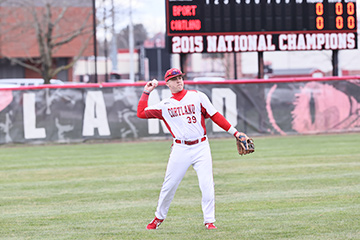 Marola, shortstop on the baseball team, chose to have his cheek swabbed at a NMDP (formerly the National Marrow Donor Program) event and was later identified as a match for a 45-year-old leukemia patient and father. During the early portion of the 2024 baseball season, he went through a lengthy process to make a bone marrow blood donation. The procedure included injections to boost his stem cell count that had to be administered an hour and a half drive away from the team’s hotel during the Red Dragons’ spring break trip to California in March, limiting his playing time during the week. The process continued with blood draws when he returned to New York. “I really was thrilled that I could potentially do something so that he can be back playing in the yard with his kids in due time,” Marola said last year in response to the award. “That’s what it was all about for me.” Danielle Bambola ’20, M ’22: women’s golf 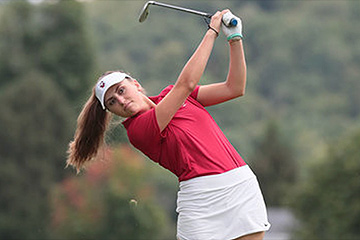 During Bambola’s freshman year in 2016 she was diagnosed with Type 1 diabetes following a bout of mononucleosis that left her in a coma for two days. After that, regular diabetic episodes required her to stop activity, rest, eat or inject insulin — often on the golf course. Then, in December of 2020 she contracted COVID-19 and her body went into diabetic ketoacidosis — a life-threatening condition in which the blood becomes acidic — and needed emergency treatment that required several days in the hospital. Overcoming those obstacles, Bambola won a total of 20 career tournament titles and earned Women’s Golf Coaches Association (WGCA) Division III second team All-America honors and first team All-East honors in both 2020 and 2021, finishing as a senior with a 17th place finish out of 131 golfers at the NCAA Division III Women’s Golf Championships. She also received the 2020 WGCA Division III Kim Moore Spirit Award, a national honor presented to a student-athlete or coach who exhibits a great spirit toward the game of golf, has a positive attitude on and off the golf course, is a role model for their team, and demonstrates mental toughness in facing challenges. Kyle Richard ’20: football 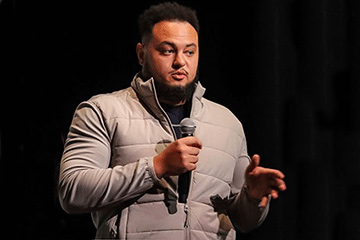 During the summer of 2017, Richard and a friend were at a party on Long Island and interrupted a sexual assault in progress. Richard pursued the assailant, who drew a gun and shot Richard twice, hitting him once in each leg. The bullets missed major arteries and bones by millimeters. Through determination and hard work, Richard beat the odds to recover in time for football season. For his actions Richard was presented with a Next Generation Award by Kristin’s Fund , a charity that aims to end domestic violence through prevention, education and awareness campaigns. He also was given a Biden Courage Award for Bystander Intervention at a ceremony featuring former President Joe Biden and became the first Division III athlete to receive an Orange Bowl Courage Award since the honor was created 16 years earlier. In 2022 he was named associate director of men’s engagement for ItsOnUs.org, the nation’s largest college-based sexual assault prevention group. Staten Island women launch flag football club05/19/2025Last spring, a trio of flag football players from Staten Island led by Samantha Toscano, then a SUNY Cortland sophomore, created the university’s first-ever women’s flag football club team. Though growing in popularity in high schools and college intramurals, traveling club teams in the sport are still a relative rarity, so campus recreational sports staff expected organizers would face similar challenges to those of other fledgling clubs during its first year. They didn’t expect the team to raise $8,000 for uniforms and travel, recruit a more-than-healthy roster of 27 players, and take second place in their league’s championship tournament after beating the top-seeded team. 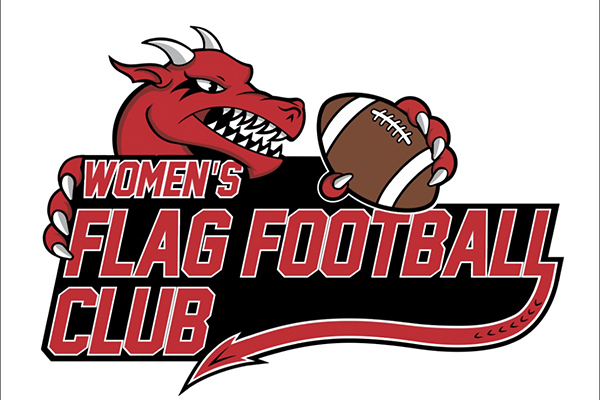 “They were a lot more ambitious and a lot more active this year than I would have expected a first-year club to be,” said Matthew Nuesell ’01 M.S. ’08, assistant director for intramural sports and sport clubs. “It was clear from the beginning that Sam was motivated. But someone must take control and move the process forward, and that was Sam.” Toscano, who in high school played for two Staten Island travel leagues, competing in places like Florida and Arizona with the Staten Island Giants and then The Home Team, began her SUNY Cortland career excited that the university offered intramural women’s flag football through Campus Recreation. Flag football is a no-tackling version of the classic American game that follows NFL rules but substitutes a tugging off strip of material attached to a belt by Velcro for tackling the opponent carrying the ball. “The only sport I’ve played on a team has been flag football,” said Toscano, now starting her senior year as an inclusive education major. “I tried other sports, but it never really resonated with me like flag football.” During her first year at Cortland, Toscano played intramural flag football, but was disappointed by the level of play. “Intramural was basically no practices and just one game a week,” Toscano said. “A lot of times we had to forfeit our games because the other team didn’t have enough players or goaltenders.” She shared her thoughts classmates Julianna DiMarzio and Vanessa Rizzo, both friends and high school flag football players from Staten Island. “We thought, ‘Why don’t we just start up a club?’” Toscano said. “It’s something we’d always played, and we wanted something like that at Cortland.” By April 2024, Toscano had lured away the cream of Cortland’s intramurals program and received 50 replies to her club interest SnapChat ad. Last fall, the inaugural 2024-25 Cortland Women’s Flag Football club launched through Campus Recreation with more than two dozen players. “I think there’s only eight out of 27 of us on the team who had played flag football before college,” Toscano said. Toscano, the club’s president, and rising seniors DiMarzio, club vice president and a speech and hearing science major, and Rizzo, club secretary and a business economics major — spent the past year recruiting, organizing and building the team’s foundation. The club took held late-night practices in Lusk Field House and met to discuss game strategy. They played their first string of games this spring. In April, just one year after the club was founded, Cortland’s team captured second place in the nine-member league championship tourney in Staten Island, having beaten the league’s top seeded varsity team, Villa Maria College in Buffalo, N.Y., in the semifinals. Cortland had been seeded fourth in the Staten Island Shootout Tournament of the new National Collegiate Flag Football League — part of the NIRSA, which stands for the National Intramural-Recreational Sports Association — with a 2-4 overall record earned at the mid-March Battle in Buffalo, N.Y. In the league’s first-ever NCFFL Championships, Cortland ultimately lost to College of Staten Island’s club team. The game is chronicled in a Long Island Advance article. Despite defeat, the Red Dragons returned home ecstatic. “I’m proud of our team, because that whole team that we played against, they have all been playing flag football probably since they were eight years old,” Toscano said of the competitors from her hometown, including coaches she had known personally. “They were a team of experienced girls with experienced coaches. We’ve just started.” This season, Cortland’s scoring standouts were rising junior sport management major “Maddie” Madeline Ryan of Long Island, Cheyenne Chamberland ’25, a childhood/early childhood education major from Buffalo, N.Y., who just graduated, and Toscano. Rising sophomore and graphic design major Emma Romach of Buffalo, N.Y., started as a first-year student, bringing defense savvy to the field and making at least five interceptions in each tournament. Last fall, fate introduced Toscano to two of the team’s three coaches, Cortland varsity football team’s coaching student interns Brandon Munk, a senior sport management major from Poughkeepsie, N.Y., and Robert Harberger, a senior sport management major from Rochester, N.Y. “I met them one day when I was playing flag football in the quad outside of Hayes Hall,” Toscano said. “They’ve all played football growing up.” This semester, Harrison Sussman, a junior coaching major from Scotch Plains, N.J., another undergraduate coaching intern with varsity men’s football, joined forces. The three men together share expertise in defense, offense, quarterbacks and special teams coaching. “They do so much for this team, especially this semester,” Toscano said. “They work with me to plan everything out, they help with practice, they help plan games.” Women’s flag football is all about strategy. “One big thing that’s different from men’s football is women don’t always have that physical advantage that men do,” Toscano said. “They must have the thinking pattern behind what they need to do.” The fledgling club quickly raised $8,000 on Snap Raise among friends, family and former high school flag football teammates to buy uniforms and travel to games this spring. Campus Recreation kicked in $1,000 for 2024-25 and the club is now eligible for funding in 2025-26. The NCAA recommends flag football for its Emerging Sports for Women program and New York state is one of 15 in the nation that have sanctioned flag football as a high school varsity sport. Next month, the New York State Public High School Athletic Association Championship for Girls Flag Football is being hosted by Cortland and Homer high schools. “It’s not going to be hard for them to figure out that our college has a flag football team,” Nuesell said. “As those opportunities are available in more high schools, those students will continue to look for opportunities in flag football. Right now, Cortland is one of the few sport clubs that exist for flag football in New York.” Cortland’s flag football club shows strong potential for next year, with the key officers in place as seniors and most members able to return as sophomores and juniors. “I’m hoping we can eventually become a varsity team,” Toscano said. “I think we can.” Visit Instagram at @cortlandwff to keep up with Cortland women’s flag football. Select an image below to begin a slide show. Capture the MomentWhen the caps go flying, it's a happy end to years of hard work at SUNY Cortland. This excited group of new graduates received a total of 1,568 bachelor’s degrees and 399 master’s degrees and certificates of advanced study during this year’s Commencement ceremonies on May 16 and May 17. There were 217 summa cum laude graduates, and 11 students who ended their time on campus with a 4.0 GPA. In Other NewsRed Dragon athletes make school history in SUNYAC rankingsCortland’s intercollegiate athletics program had its best year ever in competition against fellow SUNY schools, once again finishing first in the Dr. Patrick R. Damore State University of New York Athletic Conference (SUNYAC) Commissioner's Cup standings. Cortland won the Commissioner’s Cup, which is awarded for overall sports excellence, for the second straight year and the 19th time overall. The Red Dragons also raised the bar for athletic achievement by winning an historic 17 of 22 possible sport conference titles during 2024-25. The previous Cortland record of 11 SUNYAC titles was set in both the 2006-07 and 2012-13 seasons. “This is truly a special accomplishment by all of our programs,” said Cortland Athletic Director Mike Urtz. “It is really a testament to the support our campus shows toward athletics, as well as an amazing job by our coaches to recruit such fine talent and coach them up when they get here. “Most importantly, is a testament to our dedicated student athletes and their commitment to excellence.” In the 26 years since the Commissioners Cup was created, Cortland hasn’t done worse than second place, taking first place 19 times and second eight times. The Cup is named for Dr. Damore, the longtime SUNYAC Commissioner who retired in 2012 and passed away in 2021 at age 90. Commissioner's Cup points are awarded based on each team's finish in the SUNYAC standings, both during the regular season and in league postseason tournaments. The first-place school in each sport receives 10 points, second place receives nine points, and so on. A school’s regular-season finish is added to its postseason finish and is divided by two to determine the points for each sport. The total points earned are then divided by the number of conference sports the school sponsors. Cortland finished with an average score of 9.60 points. New Paltz finished second with an average of 7.80 points and Oneonta was third with a 7.28 average. In addition to the Cortland teams winning 17 SUNYAC titles in 2024-25, Cortland teams won the Empire 8 football title and the Northeast Women's Golf Conference (NWGC), raising the total of first-place conference finishes to 19. That means more than 75% of Cortland’s 25 varsity teams took their conference’s top spot. Cortland won five SUNYAC titles in the fall — men's cross country, women's cross country, field hockey, men's soccer and women's volleyball. The Red Dragons then claimed seven conference crowns in the winter — men's basketball, women's basketball, men's swimming and diving, women's swimming and diving, men's indoor track and field, women's indoor track and field, and wrestling. Cortland closed the year with five SUNYAC spring titles — baseball, men's lacrosse, softball, men's outdoor track and field and women's outdoor track and field. In addition, the women's soccer and women's lacrosse teams were each conference runners-up. From maximum security to university commencementSUNY Cortland senior English major Lucas Whaley, 44, will walk at the university’s Commencement ceremony on Saturday with honors, and with pride in an accomplishment he could not have imagined when he was the age when most of his fellow 2025 graduates were applying to college. When Whaley was 17, he was convicted for his role in a brutal 1998 murder and began serving 25 years of maximum-security incarceration at Auburn Correctional Facility. “I made choices, and in some cases I didn’t realize I was making choices,” Whaley said of his teenage self. “But sometimes the knowledge that people are working with, it’s messed up, it’s just plain wrong. I don’t think I ever came across anyone who didn’t think that they were doing the best that they could. I think the best thing is giving people more tools so they feel there are more options when they are making those choices.” Whaley became aware of those options thanks to Cornell University’s prison education program, Cayuga Community College and, ultimately, SUNY Cortland. 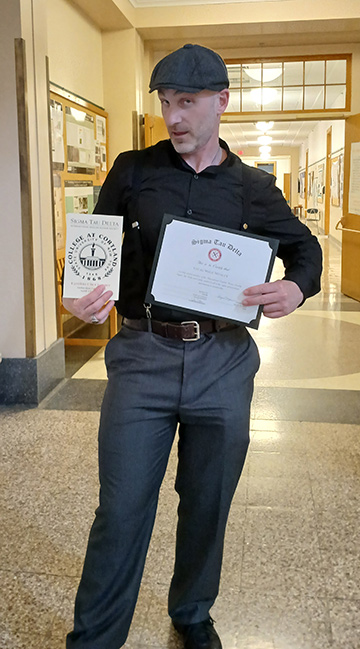 Through those institutions, Whaley began to see the world differently and developed a natural talent for raw, real and soul-searching creative writing. As a SUNY Cortland student, Whaley made the dean’s list every semester. He was inducted into Sigma Tau Delta, the international English honor society. Since being paroled two years ago, he has worked as a certified personal trainer and become a certified Building Systems and Environmental Specialist. Whaley is certified in CPR and is exploring graduate schools in his field. And he published a riveting short story, “Towards a Theory of Eternity,” in the SUNY Cortland English Department’s online literary journal, Crystallize Review. The work was selected as a finalist in the university’s Distinguished Voices Short Story Contest by guest judge author Raul Palma. It is rare for incarcerated individuals like Whaley to turn their lives around this way. That’s one reason that Rob Scott, executive director of CPEP, and New York State District 125 Assemblymember Anna Kelles, will attend Whaley’s graduation as special guests. Whaley credits taking classes through the Cornell Prison Education Program (CPEP) for 13 years with enabling him to imagine a productive life beyond prison walls. But it almost didn’t happen. “I had a real problem of trying things I thought I would fail at,” Whaley said. “Every time that it happened, it was another piece of evidence in my mind that I just wouldn’t be able to do anything worthwhile. So, it was really stepping out of my comfort zone even taking the entrance exam.” Luckily, a prison friend grabbed the CPEP application he’d filled out and dropped it in the mail before Whaley could back out. Whaley completed the CPEP program with 247 credits, an associate of arts degree from Cayuga Community College and a Certificate in the Liberal Arts from Cornell University. He now collaborates with CPEP and has given talks at Cornell about his experience. All of that was unthinkable on that fateful, March 17, 1998, day, when Whaley was one of three friends in Johnstown, N.Y., who decided to teach a fourth friend a lesson and things spun horribly, fatally, out of control. In 2017, the killing became an episode of the crime documentary series “Murder Among Friends” on the Investigation Discovery channel. At the time of the murder, Whaley was homeless, cut off from what was then a badly broken family life. He had never attended school beyond the eighth grade and had earned his GED in a county lockup at age 16 while serving time for a weapons possession conviction. 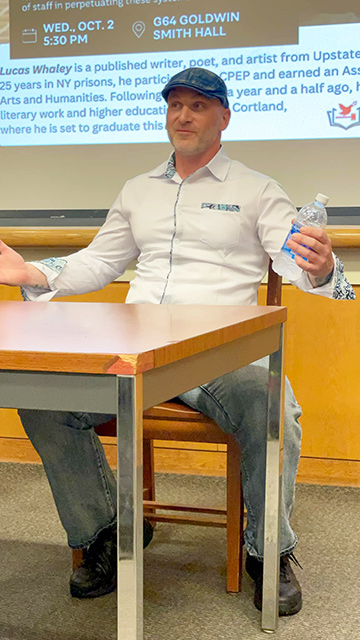 “Prison is definitely going to change you,” he said of his evolution. “And getting older changes you. And being forced to deal with people from various backgrounds and from various places with various outlooks on life is going to change you. College changes you. It gave me better tools to communicate with and better ways to understand people that I’m dealing with and that helps me to not deal with anger. “And honestly, the time I did in the box helped me reflect on a better understanding about where my anger was coming from, and that helped a lot, too. You know, when you realize that it’s not just a facet of who you are as a person but something that’s coming from somewhere. I’m a firm believer that you don’t have agency until and unless you realize you have agency. Until then, you’re just reacting to things around you and to you.” At the maximum-security Auburn Correctional Facility, he served his time for many years before he began thinking about a path for reentering society as a law-abiding citizen. He was clueless when presented with a course catalog. “I had no concept of what a major was or my options,” Whaley said. “But when looking at the course catalog and what to choose from, I knew that I wanted to write. “I had lost somebody really close to me right before I got to Auburn,” Whaley said. “I was in the box (solitary confinement), when I got the news. I was really messed up about it and started writing. It didn’t have to do with anything I was thinking or feeling, but it was just fiction, and fantastical at that. It made me feel better. Because it wasn’t about any of those things, but it was about all of those things. I just knew that writing was what I wanted to explore.” “Even in the beginning, I just barely squeaked in,” Whaley said of his performance on the CPEP entrance exam. “So I could only take one class at time my first semester. “ That was fall 2010, and it was a class in fiction writing. Every semester, each professor can move one promising part-time student up to full time. By spring 2011, Whaley earned a professor’s recommendation. “I took one class over the summer break and that fall, I really started to feel like I might be able to do this,” Whaley said. “I was having a lot of fun in the process, and I guess I didn’t expect that. Whaley knows he’s lived a very limited and confined life. That’s expressed in his short fiction. “All of it comes from life experience, not just my personal experience but what I’ve been around, seen, heard about. All of it comes from my lived experience. Just how much comes from my personal life is anybody’s guess. I had imagined quite a bit of it in some cases. But as they say, mileage will vary on that. It kind of depends on what the subtext of whatever I’m writing is.” Many people are working on reentry programs now, but prisons could offer more opportunities, too, he noted. “Prisons should be a place where people who mess up reform and go back and improve the neighborhood that they came from and then better those neighborhoods, so that we don’t have the same people from the same neighborhoods going back to prison generation after generation,” Whaley said. “These things should be shifting and changing if incarceration is doing the job that it is supposed to. But it’s not. And, honestly, more could be done to help kids before they even get on that path.” A timely repair brings Brockway clock back to lifeIn a world of screens and cell phones, checking the time is no harder than finding the latest trend on TikTok. But for more than a decade Brockway Hall was missing a very different kind of tick tock. The clock atop Brockway was an original part of the building built in 1949. It served as a public timepiece that kept students on schedule through one Cold War, three Woodstock music festivals and a new millennium, before it eventually succumbed to the ravages of rust and passing years. Its hands wandered unpunctual for more than decade. And as the uncounted seconds turned to lost months, then missed years, an accurate chronometer on campus because a distant memory. But while time stood still on the northmost reaches of campus, Don Rohel ’72 decided it was the moment to act. 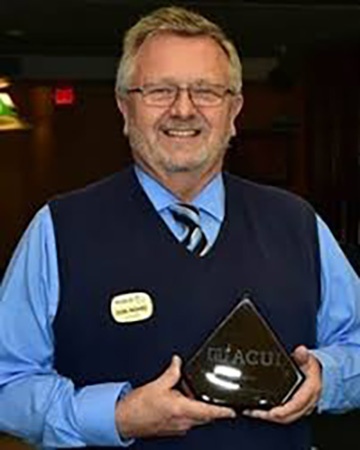 “I come up for Reunion on a regular basis every year,” Rohel said. “I got up to that part of the campus and I noticed that it’s been out of order there for a relatively long time. And somebody told me that it’s been many, many years.” Most in his mind was the clock’s very visible location near the top of Brockway Hall as it faces the rest of campus. “It does not give a good image of Cortland to have something not working that’s so prominent,” he explained. “So it became my goal was to try to get it repaired. I brought it to the attention of our Development Office and they looked into it and got all the wheels turning so that it could be repaired.” Thanks to Rohel’s gift, the clock, now officially named after Rohel’s mother and known as the Irene Louise Peppard Rohel ’40 Clock, or Rohel Clock for short, resumed its function on March 24. Workers upgraded its electrical 76-year-old power supply and replaced internal mechanism that drives the Rohel Clock’s arms. Future maintenance of the clock is also ensured by Rohel’s gift. “The rest of the clock still contains all the original hardware,” said Steve Mize, associate program coordinator for Facilities Planning, Design and Construction, and manager of the Rohel Clock project. “I knew it had been broken for some time and was delighted when I heard of the opportunity to investigate a possible repair for it.” Mize was able to find a local man, Chad Sopp, willing to tinker with the gears of an analog machine far removed from the technology of today. 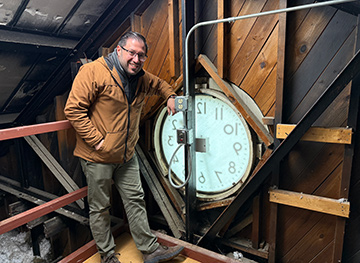 Sopp, owner of local business Timesmith Antiques, has had an interest in time and clocks since he was young, and specializes in older models. He identified the clock as an “impressive” model made by IBM long before the company was known for computers. He has done maintenance on other older clocks in the area but found the Rohel Clock to be an enticing project. With current upgrades, he expects it to run as long, or longer, than it did before without a need for repairs. “A building piece like that was a first so I had to think it over for a while, but I was definitely up for it. It was an opportunity to get to work with something in my hometown,” Sopp said. “It was more than just a job, you know. It has a lot of meaning when I get to drive by and see that running. And I know that it means a lot to so many others who've been looking at it since 1949.” Now, with the hands of time finally moving forward above Brockway Hall once again, Rohel will see the results when he visits this summer for Alumni Reunion 2025 and is recognized by the university for his help. A plaque will commemorate the new name. Rohel described his mother Irene, a teacher and fellow Red Dragon alum, as a person with the power to inspire others, often guiding them into a career in education. 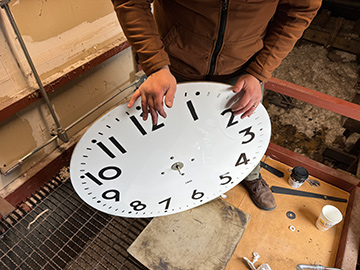 “She always motivated other people, and I have tributes that have been written to her by people who knew her or had her in class,” Rohel said. “So I thought that she deserved to be recognized for her work, and she deserved to be recognized for being a really good representative of education from Cortland.” As a student, Rohel began his own legacy at Cortland as a member of the Board of Governors, predecessor to the current Student Activities Board and majored in secondary education social studies and history, going on to a career in higher education for more than 40 years as a student center and student union director. In 2019 Don was awarded an honorary lifetime membership by the Association of College Unions International board of trustees. His other support for Cortland includes its football team, the William H. Parks Family Center for Environmental and Outdoor Education at Raquette Lake, his fraternity Lamba Phi Delta, the Parks Alumni House, Student Emergency Fund, student activities and concert commemoration. In 2021 he created the Don Rohel ’72 Student Activities Leadership Fund. “Looking back on my experience at Cortland, it opened a whole new world to me,” Rohel said. New webpage showcases best of SUNY CortlandThere’s a reason SUNY Cortland has one of the strongest student enrollments in the 64-campus SUNY system: We’re good. At a lot of things. A new SUNY Cortland Accolades page now offers a quick and easy rundown of what makes the school stand out from its peers in six categories:
“It’s always pleasing to earn recognition for the quality of our academic programs and other areas of campus life,” said President Erik J. Bitterbaum. “For more than 150 years, SUNY Cortland has helped students reach their greatest potential. This is a wonderful way to highlight that work and showcase our many institutional successes.” As Cortland gains new recognition the page will be updated with the university’s latest achievements. All items are sourced from impartial, outside sites like Collegefactual.com, Washington Monthly and U.S. News that analyze data to rate the best higher education schools in the country. You can visit the Accolades page directly or find the page under the “About” tab on SUNY Cortland’s homepage. High school scientists to meet for New York State EnvirothonThis summer, 308 of the best young scientists from across the state will gather for a second year on the SUNY Cortland campus to compete in solving environmental problems during the New York State Envirothon. Around 45 student teams plus 100 volunteers are expected on campus from Wednesday, May 28, to Thursday, May 29, for the annual competition, which is sponsored by the New York State Soil and Water Conservation District. State winners go on to the next level in the National Conservation Foundation (NCF) Envirothon, an international competition with participants hailing from 45 states, Canada, China and Singapore. This year, students will vie for victory in five categories: current environmental use; aquatic ecology; wildlife; forestry; and soils and land use. “I hope they find a love for the environment and the desire to continue as they mature, to protect our parks and environment as they move forward and teach and learn about protecting New York,” Blanche Hurlbutt, chair of the New York State Envirothon Committee, said of the student competitors. Hurlbutt, who also is the executive director of the New York Association of Conservation Districts, became involved as a member of the committee 24 years ago and has been its chair for almost a decade. Each year, more than 25,000 high school students embark on a journey to identify solutions to the critical question of how humans can balance quality of life and quality of the environment. The first Envirothon was created in 1979 in Pennsylvania and was originally named the Environmental Olympics. It was designed as a competition for high school students to encourage interest in natural resource conservation and other environmental issues. New York joined other competing states in 1990. Hobart and William Smith Colleges in Geneva, N.Y., this year is once again hosting the national competition. Last year, Cortland was selected as its successor as host of the statewide event for at least the following two years. After next year, the campus will be considered among other applications to possibly continue the role. “We chose to once again have Envirothon at SUNY Cortland because the staff was outstanding and very supportive last year and worked right alongside us during the competition,” Hurlbutt said. It helps that the school has hosted statewide events like the Empire State Senior Games and girls’ lacrosse and soccer championships and is a partner with New York State Public High School Athletic Association and Cortland Regional Sports Council. Among the biggest reasons Cortland was selected are the central location of the area within the state, its facilities and access to test sites with the varied environments needed for the competition. Those areas are kept secret from the students. Locations for this year’s investigations will not be disclosed until the students arrive on campus. Last year, the young scientists focused on the grounds of the Cortland Water Works, adjacent to campus, using animal pelts, soil pits and streams and plants to demonstrate their problem-solving and leadership skills — key components for successful teams. “They’ll see firsthand and experience out in the field all the hands-on stuff that they probably have already learned within class,” Hurlbutt said. When they aren’t doing hard work on hard data, students will unwind with an ice cream social, a movie and outdoor activities like cornhole and three-on-three basketball. Russell Briggs, Ph.D., a SUNY distinguished teaching professor and director of the Division of Environmental Science at the SUNY College of Environmental Science and Culture, will serve as guest speaker at the event. For more information about the upcoming event, visit www.nysenvirothon.org. Guests that have questions related to any campus event can reach Campus Event Management by phone at 607-753-5453 or can email the office at events@cortland.edu. IMAGES High school students from across New York state attend an Envirothon STEM competition at SUNY Cortland in 2024. On the second day of competition, teams from different school districts complete tests in five environmental science categories on the grounds of the Cortland Water Works, adjacent to campus (image by Charles Miller). Laura Gathagan honored for dedicated teachingGroundbreaking historian Laura Gathagan was recently recognized as the 2025 recipient of SUNY Cortland’s Rozanne M. Brooks Dedicated Teacher Award for giving her students a genuine taste of what it means to be a contemporary historian. “Laura’s teaching is inspired. She is truly a role model to educators working to create a positive learning culture for their students,” said past-recipient Kathleen Lawrence, a SUNY Cortland professor of communication and media studies and the Brooks Award committee chair. Gathagan doesn’t simply lecture on historical facts. She engages them in ‘historiography,’ the exploration of how history was written and what factors influenced the people who wrote it. “Historiography is a fancy word for different historians having a conversation and a debate on a particular topic,” Gathagan said. “When I use historiography in my classes, I’m trying to show my students that history isn’t just a set of dates and names. “History is a world in which we uncover new knowledge and debate it; we have a conversation about it in print. That’s why we publish. That’s why we attend professional conferences.” Her students do those very things. Three — Chelsea Lachman ’13, Jesse Goon ’19 and Brianna Gambichler ’24 — are credited in Gathagan’s 2025 book, The Queenship of Mathilda of Flanders, c. 1031-1083: Embodying Conquest (Boydell Press). Lachman and Goon helped in Gathagan’s investigations full-time, supported by SUNY Cortland Undergraduate Research Summer Fellowship awards. Typically, her future historians arrive in class ready to share their thoughts on the latest published findings they were assigned to read, according to Gathagan. These may include articles that Gathagan herself has researched abroad and written on the surprisingly strong influence of medieval European women in monastic and royal life. “She has a magical power to turn reluctant and lost students into avid followers in a matter of a few short weeks with her excitement and passion,” said former student Megan Hutchins ’13, currently the engagement and collections manager at the State of Delaware Division of Historical and Cultural Affairs. "I left every class yearning to dive deeper into the subject matter and found myself enthralled by the world of Mathilda of Flanders, despite not having an interest in medieval history prior to taking her class,” said another former student, Tony Thompson ’24, who teaches eighth grade social studies and 12th grade economics in the Watkins Glen (N.Y.) Central School District. A committee of past Brooks Award winners reviewed testimonials about Gathagan before naming her as the 18th faculty member to receive the prestigious teaching accolade, which comes with a $7,500 honorarium to enhance the recipient’s teaching initiatives. Gathagan was formally recognized with other university honorees at a pre-2025 Commencement dinner on May 15. Over two semesters, the committee evaluated Gathagan’s interactions with students, her unique and creative teaching approaches, her dedication to reaching out to students beyond the classroom and her overall ability to engage them in spirited, exciting and memorable learning experiences. Committee member Lin Lin, a professor of childhood/early childhood education and past Brooks Award recipient, noted in classroom observation how Gathagan’s students worked collaboratively in small teams to turn in one handout at the end of a session, taking turns on notetaking and with everyone participating in discussion equally. “She encouraged students to ask questions that trace how analysis of each source follows,” Lin said, describing Gathagan’s practice of analyzing different sources and explaining to the class how the time of the published source impacts the analysis. “For example, a source published in the ’70s, or a source published in the ’80s or 2025 might hold a clue to the way the topic is explored in time.” Gathagan’s assigned readings are chosen with great forethought. Aware that the articles can be very hard for non-historians to grasp, she’s not grading on reading comprehension. “The content of my courses is grounded in unfamiliar times and places,” Gathagan said. “Even the geography of what I teach is a mystery to most of my students. Thus, much of my class is spent familiarizing them with the medieval world and helping them to absorb and eventually analyze it.” Therefore, she makes strategic and sparing use of “high stakes” graded, evaluative measures. Instead, collaborative learning shapes her students’ thinking. “It gives my students a picture of the current debate in a particular field,” Gathagan said. “That field could be medieval arms and armor, or medieval women’s power in an abbatial or monastic context, or women’s power in military endeavors. … This shows them how historians are discussing sources, what arguments they are bringing to bear, when they are looking at these topics.” The Brooks Award was endowed through the generosity of the late Rozanne Marie Brooks, a SUNY Distinguished Teaching Professor and SUNY Cortland professor emerita of sociology and anthropology, and her former students, friends and colleagues. A SUNY Cortland faculty member for 36 years, Brooks died in 1997. The first award was presented in spring 1998, with 17 more honorees since then. 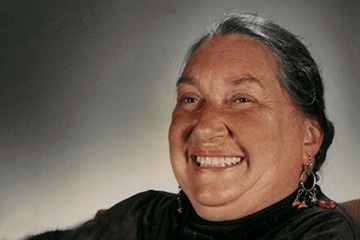 Gathagan will use her Brooks Award stipend to pursue the scholarship at the heart of her transformational teaching. The money will offset the cost for her to visit European archives containing rare and very closely held primary documents. There, she can see, read, transcribe, and translate from French or Latin, these original documents. The money also will enable her to engage in presentations and discussions at professional conferences. “It’s a crucial step to have peer review of your work at a conference, where there is a large audience of people from all over the world who are specialists in what you do, and who can hear you talk about your research and respond,” Gathagan said.  Suggest a feature story Suggest a feature story
Faculty/Staff ActivitiesJosh PelusoJosh Peluso, Information Systems and Security, gave an online lecture entitled: "Defense in Depth Strategies" at the Cybersecurity in the Era of Artificial Intelligence, Edition II Program, hosted by Babeș-Bolyai University Cluj-Napoca, Romania, on April 25, 2025. Danica SavonickStudents in Danica Savonick’s English course, Publishing Literary and Cultural Criticism, created a new journal of literary and cultural analysis called Emblaze. Issue One is now live. Read Cortland students’ interpretations of books, TV shows, movies, music and more. John SuarezAt the May 17 SUNY Civic Education Community of Practice Convening in Albany, N.Y., John Suarez, director of the Galpin Institute for Civic Engagement, co-developed and co-facilitated an active listening activity for about 65 people with Babette Faehmel, a history professor at SUNY Schenectady.  Submit your faculty/staff activity Submit your faculty/staff activity
In Memoriam Charles H. Spink, professor emeritus of chemistry, died Thursday, April 24, 2025, at the age of 89. A SUNY Cortland faculty member for 34 years, Spink's research on nucleic acid cationic lipid interactions studied the basic science that led to the development of mRNA vaccines decades later. |
The Bulletin is produced by the Communications Office at SUNY Cortland and is published every other Tuesday during the academic year. Read more about The Bulletin. To submit items, email your information to bulletin@cortland.edu
© 2025 SUNY Cortland. all rights reserved.